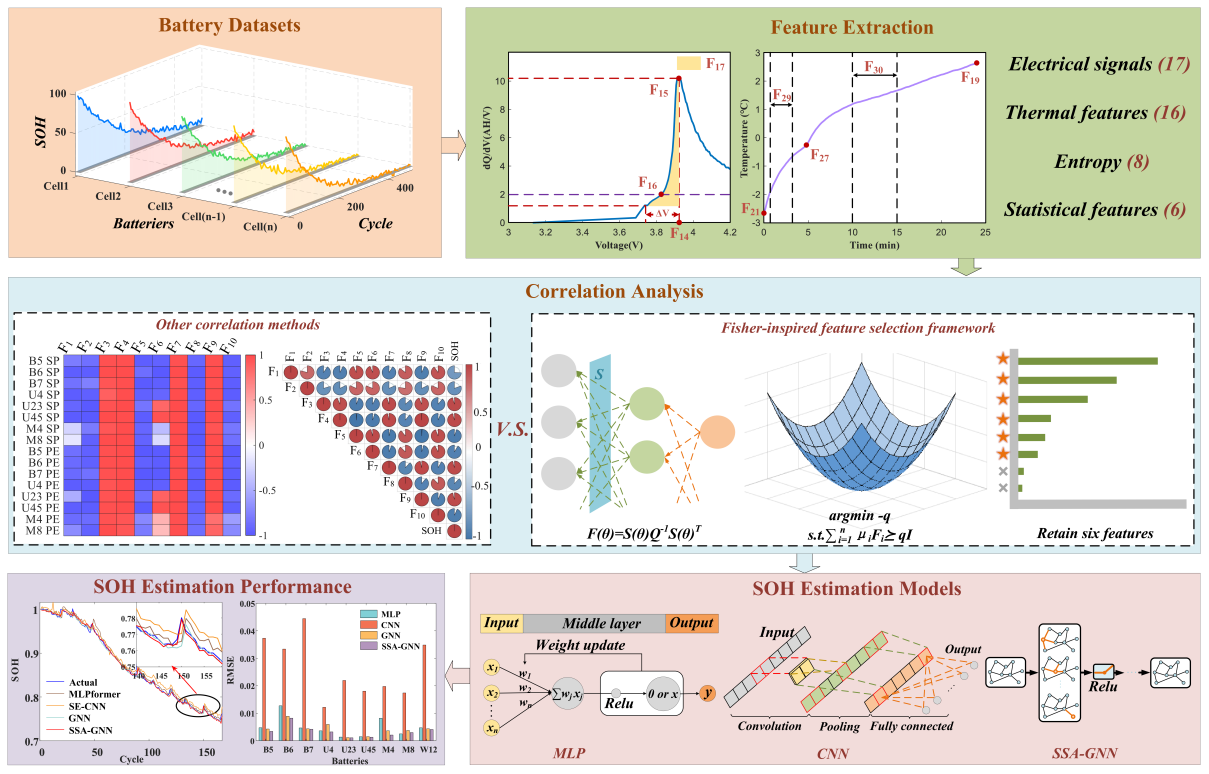The worldwide surge in electric vehicles and grid-scale storage has made lithium-ion batteries the cornerstone of clean-energy strategies. Yet their gradual capacity fade is shaped by a complex mix of temperature, cycling history and internal chemistry, which floods management systems with electrical, thermal and time-series data. Being able to tell which signals truly reflect health from those that are simply redundant noise has become a critical bottleneck for ensuring safety and predicting remaining life.
In a study published in Journal of Power Sources , Dr. DAI Houde's group from Fujian Institute of Research on the Structure of Matter, Chinese Academy of Sciences, has introduced a novel Fisher-inspired feature selection (FIFS) framework and a Sparrow Search Algorithm-optimized Graph Neural Network (SSA-GNN) model to improve the accuracy and robustness of lithium-ion battery State-of-Health (SOH) estimation.
Instead of hand-picking empirical indicators, the researchers first compiled 47 widely used electrical, thermal, entropy and statistical features from four public cell/pack datasets (NASA, UofM, MIT and Wenzhou). Then they employed the Fisher-Inspired Feature Selection (FIFS) framework, which treats feature selection as an optimal experimental-design problem. Gradient sensitivities obtained from back-propagation are assembled into a Fisher Information Matrix, and convex optimization is used to find the smallest subset that maximizes the minimum eigenvalue of this matrix. In this way FIFS assigns higher weights to variables that strongly influence model output while down-ranking redundant or noisy signals.
FIFS then evaluates every candidate through the Fisher Information Matrix, translating model-gradient sensitivity into convex weights that highlight truly informative variables while discarding correlated or high-noise entries. Tests on multilayer perceptrons(MLP), convolutional neural network (CNN) and vanilla graph neural network (GNN) backbones show that the six-feature subset delivered by FIFS cuts the mean absolute error by up to 40.6% compared with traditional Pearson, Spearman or Kendall screening.
To squeeze further value from the distilled data, the researchers wrapped the same FIMS-selected vectors into a graph structure where nodes represent adjacent voltage–temperature windows and edges encode temporal correlations. A sparrow-search algorithm automatically fine-tunes the graph convolution depth, dropout and learning rate, letting the resulting SSA-GNN capture complex, non-linear degradation paths without human tweaking. On the nine most contrasted cells the hybrid model records root mean squared error (RMSE) values of only 0.106–0.411%, outperforming recent MLPformer and SE-CNN contenders and remaining stable across −4°C, room-temperature and 45°C operation.
This study provides a robust framework for battery SOH estimation, offering significant improvements in accuracy and generalizability across diverse operating conditions. The integration of FIFS and SSA-GNN presents a powerful tool for battery health management, particularly in electric vehicles and energy storage applications.

Schematic of the FIFS-SSA-GNN workflow(Image by Dr. DAI’s group)
Contact:
Dr. DAI Houde
Fujian Institute of Research on the Structure of Matter
Chinese Academy of Sciences
Email: dhd@fjirsm.ac.cn